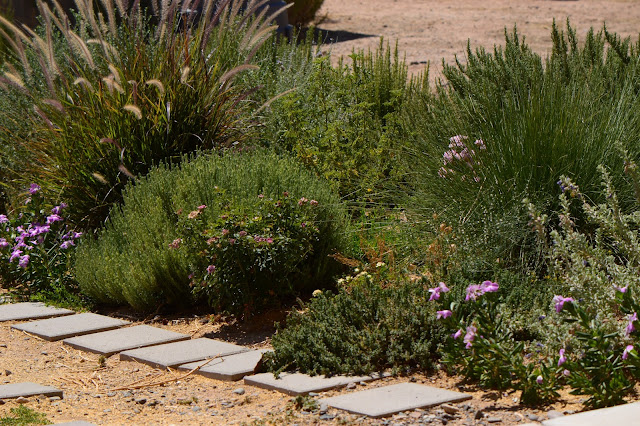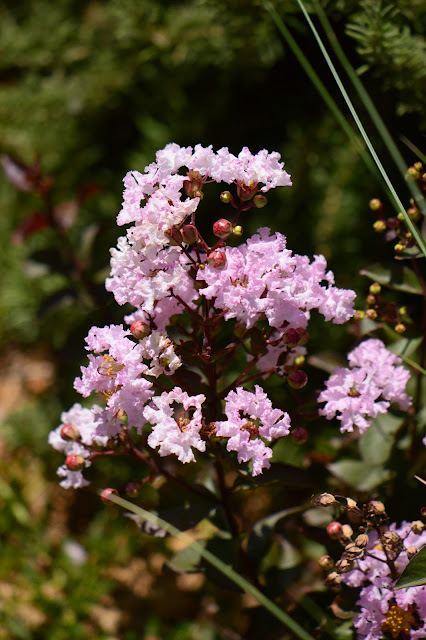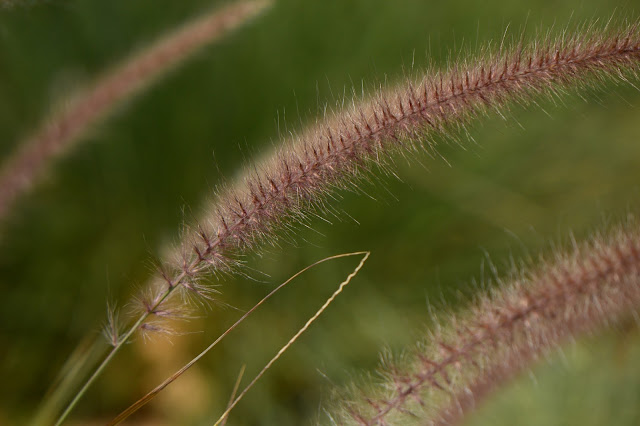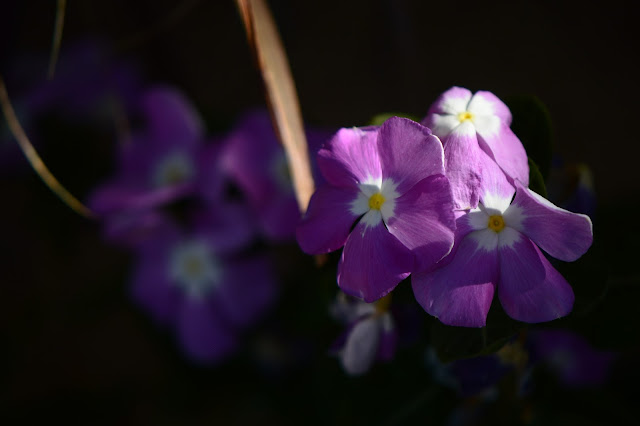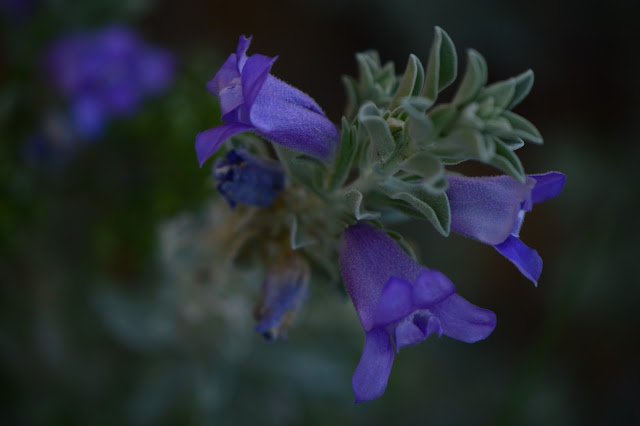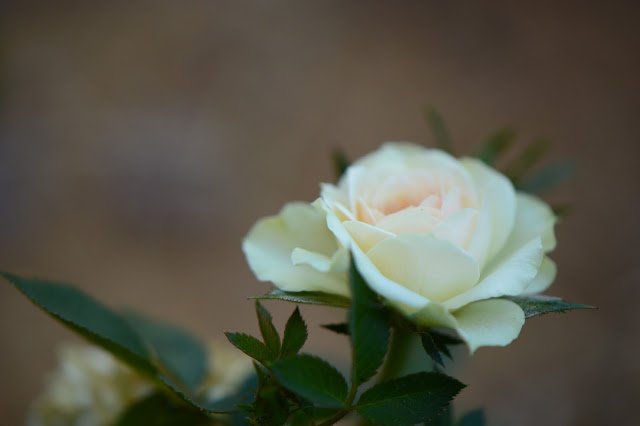This is one plant it's hard not to brag about. It boasts lacy, ferny foliage (and prickles on some stems)...
...and enormous, loose clusters of mixed yellow and orange (even red) flowers accented by long, bright stamens.
With a little supplemental water, it can grow quite large, often reaching six to eight feet (1.8 m - 2.4 m) tall even in desert conditions.
This is unequivocally a hot climate plant. It is frost sensitive and is likely to be cut down by freezing temperatures, though it has a good reputation for coming right back from the roots in mild winter gardens. But beyond that, both its growth and bloom seem to be triggered by high temperatures and plenty of sunlight.
My young plant went into the ground in June of last year (an unusually mild June!) from a 2.5 qt pot. It grew a little, then suffered frost burn during winter and took months to begin growing again. Sometime during this last June it began an impressive growth spurt. At present it is upwards of three, perhaps four, feet tall and equally wide, with a healthy showing of flowers. I am watering it occasionally, and of course it is still a young specimen needing a little extra moisture. It is not quite as drought-tolerant as some natives, but it certainly is an excellent low-water-use plant. And it blooms in July, which few native plants do!
Curiously, considering how successful it is in the low desert, it seems to have originated in the West Indies. Precisely where is apparently open to debate since it has been in cultivation time out of mind, growing throughout tropical regions; but it is uniquely associated with Barbados.
It has quite a variety of common names. In the southeastern US I find it listed as Pride of Barbados, but here in Arizona it often goes by the name of Red Bird of Paradise. Despite the resultant potential for confusion with Strelitzia reginae, I rather like the Bird of Paradise cognomen as the flowers are nearly always airborne, fluttering on their long stems as the breezes move through. They are, in fact, a good source of movement in the garden, as well as brilliant color.
Tropical though it is, it could almost be called Pride of Arizona. Why it is not grown more widely elsewhere in the subtropical and tropical US, I don't know; but it is a hallmark of southern Arizona cities, used freely in street plantings, commercial plantings, and private landscaping. Driving east in summer on I-8, the transition from California to Arizona is the transition from ocotillo in El Centro, California, to Red Bird of Paradise in Yuma, Arizona! In short, it is one of the first plants one sees and falls in love with here.
It certainly seemed the best July choice for the monthly Favorites theme hosted by Loree at Danger Garden. There were other plants I would have liked to include, especially Salvia farinacea and my newish white lantana, both of which have proven very reliable for bloom during this particularly dry summer. But I only managed to take pictures of the Caesalpinia!
Tonight's weather diary is a report in itself: Our final dust storm warning appears to have ended at last. We have had an ample amount of dust blowing on strong winds. The last and worst of it concluded with a spattering of rain, but that is all so far. Temperatures had dropped considerably when I went outdoors and began scouting for missing plants on the patio. All (I think!) have been recovered, even the baby Melocactus azureus, whose plastic pot was over 60 ft away from its starting point, while the plant itself was wedged under a pillar on the patio. So...
Weather Diary: Partly cloudy; High: 112 F (44 C); Low: 81 F (27 C); Humidity: 15%-70%
A small garden in the English style, set in the wilds of the northern Sonora Desert...
Saturday, July 30, 2016
Tuesday, July 26, 2016
Tuesday View
Changes are occuring only slowly in the South Border now. Fortunately there is some helpful structure supplied by various evergreen plants: lavender, lemon thyme, and grasses. My young Alyogyne huegelii, the wonderful Blue Hibscus, begins to be visible in the photo above as an extra bit of green behind red-leaved Pennisetum setaceum rubrum. Muhlenbergia capillaris blades, on the far right of the picture, are lengthening prior to autumn bloom.
As for flowers, the situation is much what it has been. The flush of bloom on the lavender miniature rose is over, and I need to do a thorough deadheading. The little creamy one continues to flower. Blossoms of Catharanthus roseus are plentiful, and I keep suddenly remembering how much the plants have grown since I put them in back in May. Above all, Lagerstroemia indica "Rhapsody in Pink" is proving its worth this summer with a very resilient flowering in this difficult season.
However, all is very, very dry. I have not lived here long enough to be familiar with the normal range of extremes, but this has certainly been the hottest, driest summer since we moved here. Granted, our first summer saw record-breaking rainfall, but even last year the monsoon rains supplied a significant season change between June and July, giving a good deal of relief to the plants. This year I have only seen a couple of brief downpours in the garden, enough to cool the air for a few hours, but not enough to really moisten the soil. And overall, the temperatures remain quite high, reaching 105 F - 111 F (41 C - 44 C) daily, which dries the soil further as well as being a threat in itself. There is no residual mositure to speak of, and even the wild desert plants are in emergency mode. Rubber rabbitbrush, last year a reliable source of green in the landscape, is turning brown from the bottom up; many of the wild trees are partially or completly leafless.
Through much of this week there is a chance for rain again; I certainly hope it will materialize this time!
Having moaned and groaned, here are a few of the bright spots in the South Border.
Lagerstroemia indica "Rhapsody in Pink" is a marvel.
Pennisetum setaceum rubrum has been flowering beautifully, and it is nice to have both a summer-flowering (Pennisetum) and an autumn-flowering (Muhlenbergia) grass in the same border.
And to my surprise, my miniscule Desert Willow (Chilopsis linearis "Lucretia Hamilton") is doing its best to take hold and grow after apparently succumbing to overwatering earlier in the year. Not much to show yet, but green leaves are green leaves! It's time to get a bit of mulch on it and assume it might pull through. Mature Chilopsis are in bloom now and make a lovely burst of delicate color and shade.
Most of the core plants in this border look set to survive the summer at this point, but I am worrying about the rosemary hedge behind. The rosemary plants have not received their full share of water and are showing some signs of distress, especially in the lower part of the border. Yesterday they got a good soaking, and I intend to pay closer attention to them in future!
This is the only part of the garden where the hedge is nearly complete, though the plan is to have it extend around the east and north sides as well. I have used the variety "Tuscan Blue" for its relatively upright growth habit. If all goes well, it should make a solid backdrop to the borders as well as providing screening from the tack/hay shed beyond. So it is a very integral part of the garden and should certainly be given its full share of care by the gardener!
On this last Tuesday in July, the South Border is still looking fairly good overall. The plants and I are waiting for a break in the weather! Hopefully we won't have to wait till October...!
Posted for the Tuesday View theme at Words and Herbs - thanks for hosting, Cathy!
Weather Diary: Sunny; High: 110 F (43 C)/Low: 87 F (31 C); Humidity: 18%-41%
As for flowers, the situation is much what it has been. The flush of bloom on the lavender miniature rose is over, and I need to do a thorough deadheading. The little creamy one continues to flower. Blossoms of Catharanthus roseus are plentiful, and I keep suddenly remembering how much the plants have grown since I put them in back in May. Above all, Lagerstroemia indica "Rhapsody in Pink" is proving its worth this summer with a very resilient flowering in this difficult season.
However, all is very, very dry. I have not lived here long enough to be familiar with the normal range of extremes, but this has certainly been the hottest, driest summer since we moved here. Granted, our first summer saw record-breaking rainfall, but even last year the monsoon rains supplied a significant season change between June and July, giving a good deal of relief to the plants. This year I have only seen a couple of brief downpours in the garden, enough to cool the air for a few hours, but not enough to really moisten the soil. And overall, the temperatures remain quite high, reaching 105 F - 111 F (41 C - 44 C) daily, which dries the soil further as well as being a threat in itself. There is no residual mositure to speak of, and even the wild desert plants are in emergency mode. Rubber rabbitbrush, last year a reliable source of green in the landscape, is turning brown from the bottom up; many of the wild trees are partially or completly leafless.
 |
| ...seen on a walk yesterday morning; July beauty in the desert... Many desert plants are naturally summer deciduous. |
Having moaned and groaned, here are a few of the bright spots in the South Border.
Lagerstroemia indica "Rhapsody in Pink" is a marvel.
Pennisetum setaceum rubrum has been flowering beautifully, and it is nice to have both a summer-flowering (Pennisetum) and an autumn-flowering (Muhlenbergia) grass in the same border.
And to my surprise, my miniscule Desert Willow (Chilopsis linearis "Lucretia Hamilton") is doing its best to take hold and grow after apparently succumbing to overwatering earlier in the year. Not much to show yet, but green leaves are green leaves! It's time to get a bit of mulch on it and assume it might pull through. Mature Chilopsis are in bloom now and make a lovely burst of delicate color and shade.
Most of the core plants in this border look set to survive the summer at this point, but I am worrying about the rosemary hedge behind. The rosemary plants have not received their full share of water and are showing some signs of distress, especially in the lower part of the border. Yesterday they got a good soaking, and I intend to pay closer attention to them in future!
This is the only part of the garden where the hedge is nearly complete, though the plan is to have it extend around the east and north sides as well. I have used the variety "Tuscan Blue" for its relatively upright growth habit. If all goes well, it should make a solid backdrop to the borders as well as providing screening from the tack/hay shed beyond. So it is a very integral part of the garden and should certainly be given its full share of care by the gardener!
On this last Tuesday in July, the South Border is still looking fairly good overall. The plants and I are waiting for a break in the weather! Hopefully we won't have to wait till October...!
Posted for the Tuesday View theme at Words and Herbs - thanks for hosting, Cathy!
Weather Diary: Sunny; High: 110 F (43 C)/Low: 87 F (31 C); Humidity: 18%-41%
In a Vase: Fireworks and Roses
The culprits were Caesalpinia pulcherrima and Hamelia patens. In the case of the Caesalpinia, I will perhaps try the boiling water trick at some point as it is a fairly woody plant, albeit tender. The flowers would be grand in a vase if one could get them to last any time!
Though I have no immediate plans for testing the Caesalpinia again, I did want to try the Hamelia a second time because I felt that the wilting could well be the result of the shrub being a bit wilty itself when I cut the flowers. So this morning I cut more for today's vase, taking them from good, turgid growth. Results are much better! The slender, scarlet blooms seem pleased at being in water in a cool room.
As you can see, there were also plenty of blooms available from rose "Crown Princess Margareta". I was able to cut a full cluster as well as a couple of singles.
They combine with Russelia and Lantana to make a warm, summery bouquet.
The two red trumpet types form an interesting combination. Each plant exhibits distinctly different growth habits, with Russelia being a loose fountain of green stems and Hamelia being quite shrubby.
The other component of the vase is lantana, of which I have used two types, both the named "Denver Red" (the dark cluster in the photo below)...
...and an unknown orange variety piled beneath a couple of palm trees in what is now the Rose Border. Lantana is a very faithful plant here, putting on bloom at intervals throughout the year.
I used one of my handbuilt vases which is finished with a dark brown glaze. Its bouyant form seemed to complement the very vivid colors of the flowers.
I really missed posting my vase last Monday; this meme is addictive! Thanks, as always, to Cathy for hosting it at Rambling in the Garden!
Weather Diary: Some clouds and hot: High: 108 F (42 C)/Low: 87 F (31 C); Humidity: 20%-43%
Wednesday, July 20, 2016
Garden Tour from a Truant
The fact is, I've missed two regular weekly memes already and it's only Tuesday night! I am sitting at the computer looking across at Monday's vase. There was no way of knowing for certain that Caesalpinia pulcherrima and one stem of Hamelia patens would not survive cutting well. As it happens, it seems they don't! So there went the Monday Vase as yesterday was too busy for a second try. As for today, I felt that turning and watering that compost heap simply had to be done... and I was too bushed afterward to take pictures of the South Border. Trust me, it hasn't changed much since last week!
Instead I took a quiet, fairly random look at the garden, camera in hand. Here is the mini tour.
Caesalpinia pulcherrima, while not useful for bouquets, is growing well in the East Border. It is seen here with Artemesia x "Powis Castle" behind.
Then this miniature rosebud caught my eye.
Also there is some good bloom on Eremophila hygrophana.
And if you get down and look, there are nearly always bees on the nearby oregano.
Penstemon pseudospectabilis "Coconino County" is still popping up flowering stems. This gives it a far, far longer bloom season than P. parryi, which is decidedly a spring-flowering species for me.
In the Rose Border there are more blooms on Crown Princess Margareta.
As for that trip to the garden center, July is a good time to go cactus shopping. Results are my first Golden Barrel cactus (Echinocactus grusonii).
And at last I found plugs of Eustoma grandiflorum. I'm debating how soon to try planting any of these out into the garden.
And back on the bargain shelves, there was Tetraneuris acaulis glabra, the low-growing evergreen that sends up cheerful yellow daisies through much of the year. This plant looks a bit wispy, but these generally look pretty wispy when young. I'm fairly sure it has a good deal of life left in it; at any rate it seemed well worth a dollar!
There would certainly have been more purchases if I hadn't recently placed my iris order! Besides, don't tell anyone, but I already have several small cactus plants waiting on the patio. Among them is the beautiful blue of Melocactus azureus.
If cooler weather ever gets here, I'll have a good deal of planting to do!
Weather Diary: Fair; High: 107 F (42 C)/Low: 86 F (30 C); Humidity: 18%-48%
Saturday, July 16, 2016
Garden Bloom in July
But the garden still has a surprising amount of bloom. Some of the blossoms are a bit crispy; others have a tendency to wilt. But there is bloom! Here is a brief tour.
The two Lagerstroemias, L. indica "Dynamite"...
...and L. i. "Rhapsody in Pink".
There is the indefatigueable Russelia equisetiformis "Big Red".
Along with Russelia, I was relying on Hamelia patens to supply nectar for hummingbirds, who have, however, apparently left to spend the hot season elsewhere! The Hamelia is a wonderful plant, but it is planted in a very fast-draining part of the garden, and I am having trouble keeping enough water on it. Perhaps by next summer it will be better established and I will have amended the soil enough to keep moisture levels more even.
It is certainly the tropicals that are the source of mid-July bloom in this garden!
 |
| Catharanthus roseus in lavender and white |
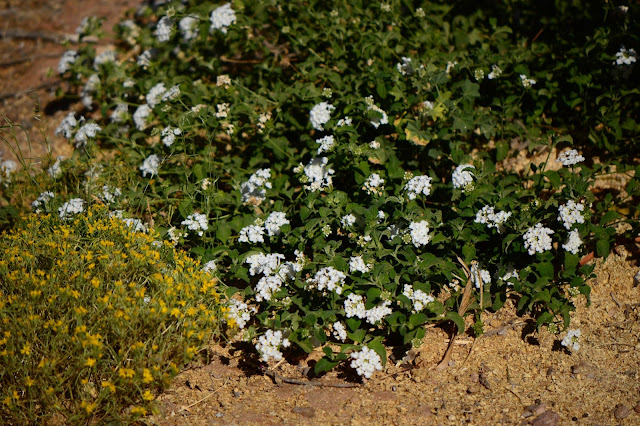 |
| White lantana with native chinchweed growing nearby. I normally allow some chinchweed to add a bit of yellow to the late summer garden. |
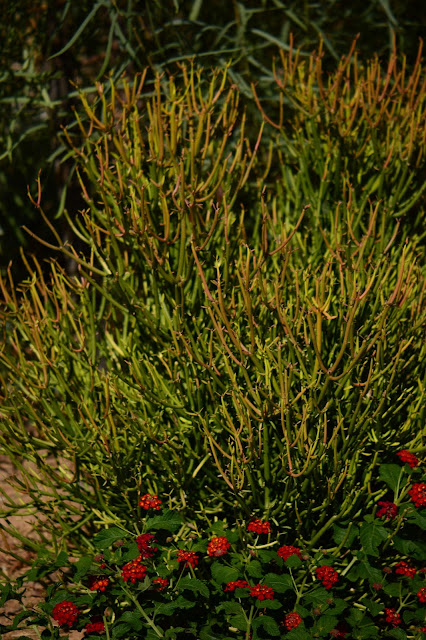 |
| Lantana "Denver Red" filling in below Euphorbia tirucalli "Firesticks" |
 |
| Mirabilis jalapa (Four o'Clocks), unopened flowers |
 |
| Cuphea ignea "Vermillionaire" |
 |
| Caesalpinia pulcherrima |
But there are some dry country plants in bloom as well. Alyogyne huegelii is sproradically in bloom though not today. There is also Eremophila hygrophana.
And there is the native Penstemon pseudospectabilis "Coconino County". To my surprise, it is still putting out flowers, having been more or less in bloom since late spring. The foliage behind belongs to Hippeastrum "Naranja".
There are also grass flowers.
 |
| Pennisetum setaceum "Rubrum" |
And a few roses, especially among the miniatures, such as my little creamy white one. (I think it once had a fair amount of pink to it, but that was long before the heat began!)
Crown Princess Margareta is also trying to do her bit.
Among the surprises are continuing bloom from Dianthus...
...and the reblooming iris "Clarence", with this being its second bloom.
And one of the best of all is Salvia farinacea, planted near Hamelia patens, but much more tolerant of the low water conditions. It has been in nearly continuous bloom for months.
 |
| Salvia farinacea |
We are still waiting our first real monsoon rains, with another chance in the forecast through this coming week. It would make such a difference! Right now the plants are dealing with the triple difficulties of high heat, very low humidity, and hot winds. Just about everyone would be happy with a good downpour here.
In the meantime, I'm pleased that planning from last summer has resulted in a much better range of flowering plants to tide over the hottest months. This is the desert garden's doldrums, much different from growing in more temperate regions. To see many other July gardens around the world, don't forget to visit May Dreams Gardens!
 |
| Penstemon pseudospectabilis "Coconino County" |
Weather Diary: Sunny; High: 110 F (43 C)/Low: 88 F (31 C); Humidity: 12%-29%
Labels:
Caesalpinia,
Catharanthus,
Cuphea,
Dianthus,
Eremophila,
GBBD,
Hamelia,
Iris,
Lagerstroemia,
Lantana,
Mirabilis,
Pennisetum,
Penstemon,
rose,
Russelia,
Salvia,
Salvia farinacea,
tropical
Subscribe to:
Comments (Atom)






